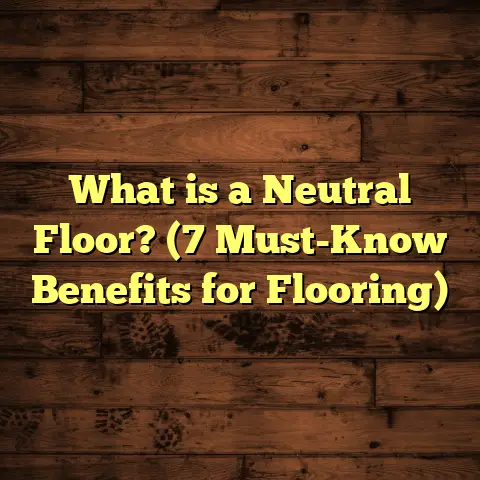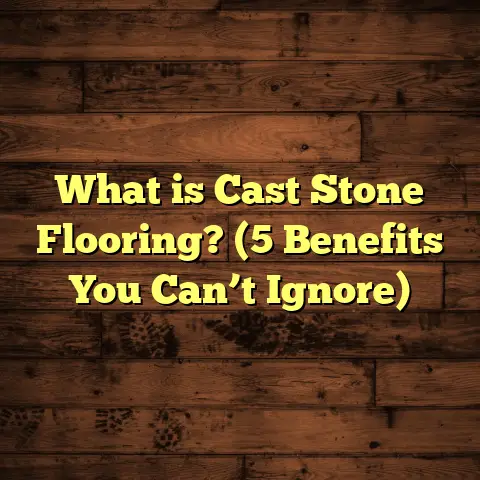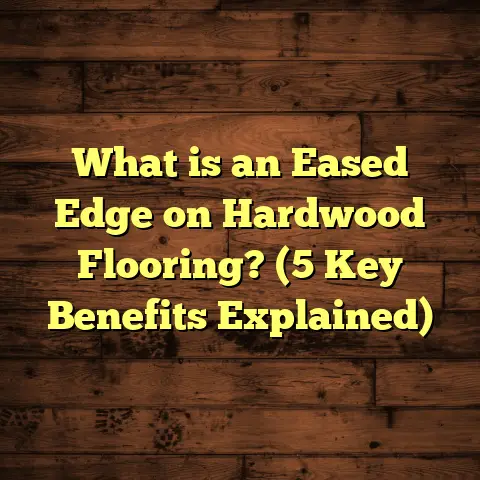What is VOC for a Floor? (5 Key Facts for Healthy Spaces)
I still remember the day I first stepped into my newly built home, the fresh scent of new construction filling the air. It was exciting but also a little overwhelming, especially when I started noticing that typical “new floor smell.” That scent, as I later found out, was something called VOCs—or Volatile Organic Compounds—coming from the materials used in the flooring installation. It got me thinking deeply about the air I was breathing inside my own home. How many of us pause to think about what our floors might be releasing into the air? Over years of working as a flooring contractor and diving into research, I learned that VOCs matter a lot when it comes to creating healthy living spaces. And I want to share everything I’ve learned in detail with you.
What is VOC for a Floor?
VOC stands for Volatile Organic Compounds. Basically, these are chemicals that easily evaporate into the air at normal room temperatures. They come from solids or liquids and can be found in many building materials and household products.
When we talk about VOCs in flooring, we’re mainly referring to the gases released by flooring materials, adhesives, finishes, and sealants. These compounds can off-gas or “off-evaporate” into your indoor environment. For example, when you install laminate floors, the glue holding the layers together can release VOCs. Similarly, finishes like varnishes or sealants applied on hardwood floors might contain solvents that evaporate over time.
Why Should You Care?
Because these gases don’t just disappear the moment you install your floor. They linger in the air and can impact your indoor air quality. Poor indoor air quality affects millions of people worldwide. According to the EPA, indoor air can be two to five times more polluted than outdoor air, largely due to VOCs emitted from household products and building materials.
Some of the most common VOCs found in floor materials include formaldehyde (which has been linked to respiratory issues), benzene, toluene, and xylene. These aren’t just chemical names; they’re substances that can cause headaches, dizziness, irritation of eyes and throat, and longer-term health effects if exposure is high or prolonged.
How VOCs Impact Your Home Environment
Ever walked into a freshly renovated room and felt a strong chemical odor? That’s VOCs being released into the air. This off-gassing usually peaks right after installation and decreases over time but can sometimes last for months or even years depending on what materials were used.
One thing I noticed early in my career was how clients who chose traditional vinyl flooring often complained about headaches or nausea right after installation. On the other hand, those who opted for natural hardwood finished with water-based sealers had fewer complaints.
This is because synthetic materials or solvent-based finishes tend to have higher VOC emissions than natural or water-based products.
In a study conducted by the Lawrence Berkeley National Laboratory, researchers measured VOC concentrations in homes that had recently installed new flooring. The results showed that homes with low-VOC flooring products had up to 40% lower total VOC levels in indoor air compared to homes with standard materials.
This is significant because people spend around 90% of their time indoors—whether at home, work, or school—and breathing cleaner air can reduce risks of respiratory problems and improve overall well-being.
5 Key Facts About VOCs and Flooring for Healthy Spaces
Let’s break down what you really need to know about VOCs in flooring.
1. Flooring Materials Differ Greatly in VOC Emissions
Not all floors are created equal when it comes to chemical emissions.
- Solid Hardwood: Natural wood itself emits very few VOCs but finishes can add chemicals. Water-based polyurethane finishes are much better than oil-based or solvent-based.
- Engineered Wood: Layers of veneer glued together may release formaldehyde from adhesives unless certified low-emitting.
- Laminate Flooring: Uses adhesives and resins that can off-gas formaldehyde and other VOCs.
- Vinyl Flooring: Often contains plasticizers like phthalates which contribute to VOC emissions.
- Carpet: Releases VOCs from adhesives and backing materials; also traps other airborne chemicals but can re-emit them later.
I always recommend clients look for certifications like FloorScore or GREENGUARD Gold when selecting flooring products. These labels mean independent labs tested them to meet strict limits on VOC emissions.
2. Installation Methods Impact VOC Levels
How you install your flooring matters just as much as what you install.
For example, using solvent-based adhesives instead of water-based ones can double or triple VOC emissions during installation. Ventilation during this process is critical. I’ve seen many homeowners underestimate this part.
In one project, we installed engineered hardwood with a low-VOC adhesive and kept windows open for several days afterward. The family noted less chemical odor and no headaches compared to their previous renovation experience.
High humidity or warm temperatures can also increase off-gassing because heat accelerates chemical evaporation. So timing your installation during cooler months or ensuring climate control helps reduce initial emission peaks.
3. Off-Gassing Declines Over Time but Can Last
Most VOC emissions are highest during the first 48 to 72 hours after installation but can continue at lower levels for months.
According to a study published in Indoor Air journal, formaldehyde emissions from engineered wood flooring dropped by more than 50% after six months but were still detectable one year later.
This means that ventilation isn’t just a one-time thing. Continuous airflow over the first several months improves indoor air quality significantly.
I always advise my clients to keep windows open as much as possible for at least two weeks post-installation and use air purifiers if feasible.
4. Maintenance Choices Affect Indoor Air Quality
Your floor’s impact on air quality doesn’t end once it’s installed.
Many cleaning products contain ammonia or solvents which add more VOCs back into your environment. Using natural cleaners like vinegar solutions or low-VOC certified products is a smarter option.
Waxing floors? Traditional waxes often contain petroleum distillates which increase VOC levels indoors. Water-based or natural wax alternatives reduce this problem.
Also, keeping floors dry prevents mold growth—a hidden source of indoor air pollutants that can worsen respiratory issues.
I once worked with an elderly couple whose hardwood floors were regularly cleaned with harsh chemicals. After switching to eco-friendly cleaners, they reported less coughing and fewer allergy symptoms.
5. Cost Considerations: Balancing Health and Budget
I get asked all the time: “Are low-VOC flooring options more expensive?” The answer is—it depends.
Some premium low-VOC products cost more upfront but reduce health risks and potential future costs related to poor indoor air quality (doctor visits, missed workdays). Plus, they often last longer due to better manufacturing standards.
To help manage budgets while focusing on healthier choices, I use FloorTally—a tool that calculates installation costs including materials, labor, and waste factors based on local rates. This helps me provide transparent estimates whether clients want solid hardwood with water-based finishes or affordable low-VOC laminates.
FloorTally saves me time by consolidating data and reducing back-and-forth on pricing. It also helps me compare different flooring scenarios quickly so clients can make decisions that fit both budget and wellness goals.
My Personal Take: Why I Prioritize Low-VOC Flooring
Over my years installing floors, I’ve seen firsthand how flooring choices affect people’s comfort and health.
One memorable case was a family with two kids who suffered from frequent asthma attacks. They switched from carpet with synthetic adhesives to natural bamboo flooring sealed with non-toxic oils. Within weeks, their symptoms improved noticeably—no more wheezing or nighttime coughing fits.
For me personally, choosing low-VOC floors transformed my home office environment too. Long hours working felt less tiring without headaches or throat irritation from chemical fumes common in some traditional floor finishes.
These experiences cemented my belief that every homeowner should consider VOCs—not just style or cost—when picking floors.
Diving Deeper: What Research Says About Flooring VOCs
Beyond anecdotal evidence, plenty of studies have quantified how flooring affects indoor air quality:
- A study by Health Canada found that homes with laminate flooring had formaldehyde levels ranging from 10 to 40 micrograms per cubic meter (µg/m³), compared to less than 10 µg/m³ for hardwood with water-based finish.
- Research published in Science of The Total Environment shows that vinyl flooring contributes phthalates which indoor dust accumulates over time—raising exposure risks especially for children.
- An investigation by the National Institute of Environmental Health Sciences (NIEHS) indicated that using low-VOC adhesives reduced total VOC emissions by nearly 60% during installation.
These data points confirm what I’ve observed: material choice and installation methods make a big difference in indoor air health.
Real-Life Case Study: Low-VOC Flooring in a School Setting
I once worked on a project renovating classrooms at an elementary school where parents were concerned about asthma triggers among students. We recommended bamboo flooring sealed with plant-based oils combined with zero-VOC adhesives.
After installation:
- Indoor air tests showed a 35% reduction in total VOC concentrations compared to old carpeting.
- Teachers reported fewer student complaints related to headaches or dizziness.
- The school saw improved attendance rates over six months—possibly linked to better air quality.
This case taught me how impactful low-VOC flooring is not just at home but in public spaces where vulnerable populations spend long hours.
How To Identify Low-VOC Flooring Products Yourself
If you want to shop smarter:
- Look for FloorScore certification: Products meeting this standard have indoor emissions below thresholds set by California’s Department of Public Health.
- Check GREENGUARD Gold certification: This label ensures compliance with strict chemical emission limits suitable for sensitive individuals such as children.
- Ask manufacturers for Safety Data Sheets (SDS) detailing VOC content.
- Avoid products labeled “no added formaldehyde” unless they have independent testing backing this claim.
- Choose finishes and adhesives specifically marketed as water-based or zero-VOC.
If you’re ever unsure, ask your flooring contractor about low-VOC options—they should be familiar with these standards.
Installation Best Practices To Minimize VOC Exposure
When installing floors yourself or hiring pros:
- Always ventilate well during and after installation.
- Use fans and open windows whenever weather allows.
- Opt for adhesives labeled low-VOC or no-VOC.
- Avoid installing floors during hot humid weather if possible.
- Allow newly installed floors to off-gas before moving furniture back in (preferably at least 3–7 days).
I once helped a client who ignored ventilation advice during laminate installation; they experienced headaches for weeks afterward until we increased airflow dramatically.
Maintenance Tips For Healthy Floors
Maintaining floors properly ensures they stay beautiful without adding harmful chemicals:
- Clean regularly using gentle soaps or natural solutions like diluted white vinegar.
- Avoid ammonia-based cleaners which increase indoor pollution.
- Refinish hardwood floors using water-based sealers rather than solvent-based lacquers.
- Keep humidity balanced (30–50%) to prevent mold growth under floors.
- Use mats at entrances to reduce dirt and dust accumulation—dust often carries VOC particles too.
Simple changes here can keep your indoor environment cleaner long term.
What About New Technologies?
The flooring industry is evolving quickly with innovations aimed at reducing VOC emissions:
- More manufacturers are producing formaldehyde-free engineered wood using soy-based glues.
- Natural oil finishes derived from plants replace chemical lacquers.
- Some companies offer recycled-content vinyl with reduced phthalates.
- Advances in adhesive formulations have created zero-VOC options widely available today.
These trends make it easier than ever to find healthy flooring without sacrificing durability or style.
FAQs About VOCs and Flooring
Q: Is it true that “natural” always means low-VOC?
Not necessarily. Even natural materials can have high-VOC finishes if treated with solvent-based sealants. Always check product specs.
Q: How long do I need to ventilate after installing new floors?
At least 3–7 days ideally; longer if possible. Keep airflow consistent during this period for best results.
Q: Can I live in my home immediately after installing new flooring?
Yes, but if you’re sensitive (children, elderly, asthma sufferers), consider limiting time spent in rooms with fresh installation until off-gassing decreases.
Q: What if my budget is tight?
Low-VOC laminates exist at reasonable prices—ask your contractor about options balancing cost and health benefits.
Q: How can I test for VOC levels at home?
You can buy indoor air quality test kits online or hire professionals who use specialized equipment for accurate measurement.
Wrapping Up My Thoughts
Thinking about VOCs when selecting your floor might feel overwhelming at first. But trust me—it’s worth it for your health and comfort. Floors are one of the largest surfaces inside your home; what they release into the air affects every breath you take indoors.
Choosing materials wisely, installing carefully, maintaining thoughtfully—all these small steps add up to creating spaces where families thrive without invisible chemical burdens.
And if cost seems tricky? Tools like FloorTally make figuring budgets easier so you get clear numbers right away without guesswork.
If you ever want help picking the right floor or have questions about making your home healthier through flooring choices—just ask. I’m happy to share everything I know because living well starts beneath your feet.





